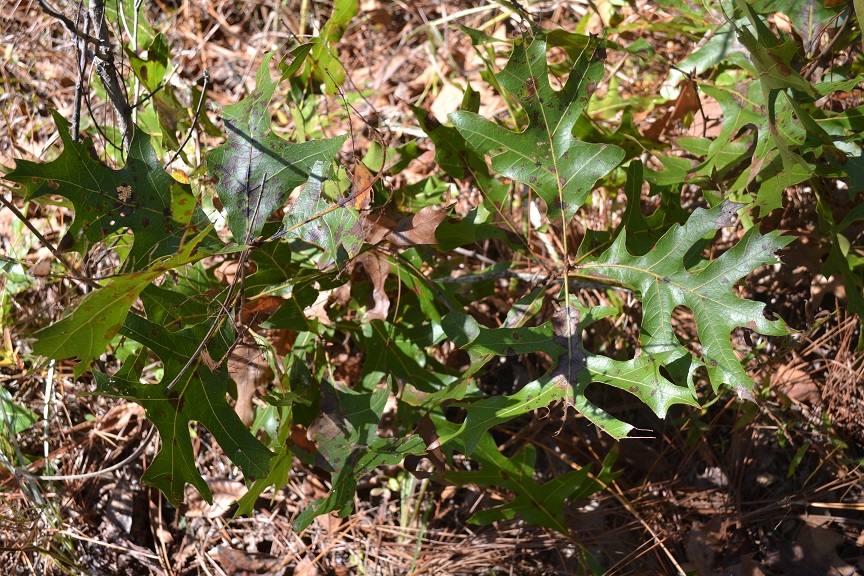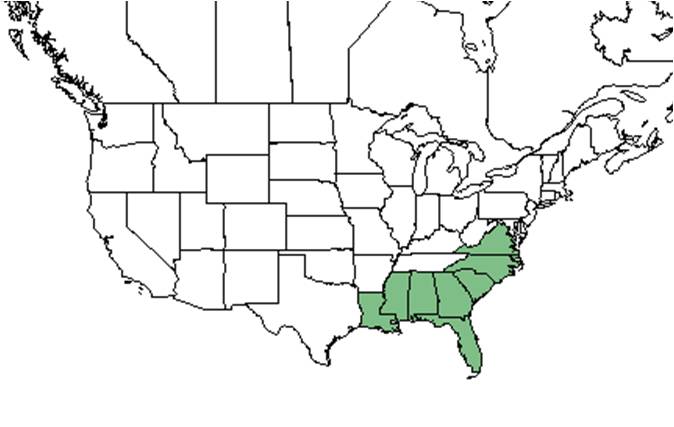Difference between revisions of "Quercus laevis"
(→Ecology) |
HaleighJoM (talk | contribs) (→Ecology) |
||
| (One intermediate revision by one other user not shown) | |||
| Line 54: | Line 54: | ||
===Fire ecology=== <!--Fire tolerance, fire dependence, adaptive fire responses--> | ===Fire ecology=== <!--Fire tolerance, fire dependence, adaptive fire responses--> | ||
| − | Populations of ''Quercus laevis'' have been known to persist through repeated annual burns.<ref>Robertson, K.M. Unpublished data collected from Pebble Hill Fire Plots, Pebble Hill Plantation, Thomasville, Georgia.</ref> | + | Populations of ''Quercus laevis'' have been known to persist through repeated annual burns.<ref>Robertson, K.M. Unpublished data collected from Pebble Hill Fire Plots, Pebble Hill Plantation, Thomasville, Georgia.</ref><ref>Platt, W.J., R. Carter, G. Nelson, W. Baker, S. Hermann, J. Kane, L. Anderson, M. Smith, K. Robertson. 2021. Unpublished species list of Wade Tract old-growth longleaf pine savanna, Thomasville, Georgia.</ref> |
| − | ===Pollination and | + | <!--===Pollination===--> |
| + | ===Herbivory and toxicology===<!--Common herbivores, granivory, insect hosting, poisonous chemicals, allelopathy, etc--> | ||
''Quercus laevis'' has been observed to host froghoppers such as ''Prosapia bicincta'' (family Cercopidae), as well as planthoppers such as ''Oecleus borealis'' (family Cixiidae), members of the Achilidae family such as ''Catonia cinctifrons, Catonia nava'', and ''Metcalfa pruinosa'' (family Flatidae), treehoppers from the Membracidae family such as ''Cyrtolobus fuliginosus, C. ovatus, C. puritanus, C. tuberosus, Ophiderma definita, O. pubescens,'' and ''Smilia camelus'', and plant bugs from the Miridae family such as ''Atractotomus miniatus'', ''Lygus lineolaris'', and ''Pseudoxenetus regalis''.<ref>Discoverlife.org [https://www.discoverlife.org/20/q?search=Bidens+albaDiscoverlife.org|Discoverlife.org]</ref> The acorns of ''Quercus laevis'' have been identified as a major food source for white-tailed deer, black bears, northern | ''Quercus laevis'' has been observed to host froghoppers such as ''Prosapia bicincta'' (family Cercopidae), as well as planthoppers such as ''Oecleus borealis'' (family Cixiidae), members of the Achilidae family such as ''Catonia cinctifrons, Catonia nava'', and ''Metcalfa pruinosa'' (family Flatidae), treehoppers from the Membracidae family such as ''Cyrtolobus fuliginosus, C. ovatus, C. puritanus, C. tuberosus, Ophiderma definita, O. pubescens,'' and ''Smilia camelus'', and plant bugs from the Miridae family such as ''Atractotomus miniatus'', ''Lygus lineolaris'', and ''Pseudoxenetus regalis''.<ref>Discoverlife.org [https://www.discoverlife.org/20/q?search=Bidens+albaDiscoverlife.org|Discoverlife.org]</ref> The acorns of ''Quercus laevis'' have been identified as a major food source for white-tailed deer, black bears, northern | ||
bobwhite quail, and wild turkeys.<ref>Harlow, R.F., 1990. Quercus laevis Walt. Turkey Oak. Silvics of North America, 2.</ref> | bobwhite quail, and wild turkeys.<ref>Harlow, R.F., 1990. Quercus laevis Walt. Turkey Oak. Silvics of North America, 2.</ref> | ||
Latest revision as of 14:48, 15 July 2022
| Quercus laevis | |
|---|---|

| |
| Photo by Kevin Robertson | |
| Scientific classification | |
| Kingdom: | Plantae |
| Division: | Tracheophyta- Vascular plants |
| Class: | Magnoliopsida - Dicotyledons |
| Order: | Fagales |
| Family: | Fagaceae |
| Genus: | Quercus |
| Species: | Q. laevis |
| Binomial name | |
| Quercus laevis Walter | |

| |
| Natural range of Quercus laevis from USDA NRCS Plants Database. | |
Common name: Turkey oak
Contents
Taxonomic notes
Synonym: Quercus catesbaei Michaux.[1]
Description
A description of Quercus laevis is provided in The Flora of North America.
Distribution
Quercus laevis is endemic to the longleaf pine range from southeastern Virginia to central Florida and west to southeast Texas.[2]
Ecology
Habitat
Q. laevis has been found in sandy scrub, scrub oak sand ridge, open pine-oak woodland, and open longleaf pine forest.[3] It is also found in disturbed areas like secondary slash pine forest.[3]
Associated species: Q. incana, Baptisia lecontei, Pteridium aquilinum, Sassafras albidum, Bapitisa lecontei, Pteridium aquilinum, and Sassafras albidum.[3]
Quercus laevis is restricted to native groundcover with a statistical affinity in upland pinelands of South Georgia.[4]
Q. laevis reduced its occurrence in response to agriculture-based soil disturbance in South Carolina longleaf forest communities.[5] It has shown resistance to regrowth in reestablished longleaf pinelands that were disturbed by agriculture, making it a remnant woodland indicator species.[6] This species has become absent in response to military training in west Georgia longleaf forests.[7] It has reduced its frequency and density in response to roller chopping in northwest Florida sandhills.[8] Additionally, Q. laevis has become absent and decreased its occurrence in response to agriculture in southwest Georgia.[4]
This species was unaffected by agriculture in North Carolina longleaf pinelands.[9]
It increased its density in response to roller chopping in west Florida pinelands. It has shown regrowth in reestablished pineland that were disturbed by this practice.[10]
When exposed to soil disturbance by military training in West Georgia, Quercus laevis is frequent and abundant in the Peninsula Xeric Sandhills and Panhandle Xeric Sandhills community types as described in Carr et al. (2010).[11] When exposed to soil disturbance by military training in West Georgia,Quercus laevis is frequent and abundant in the Peninsula Xeric Sandhills and Panhandle Xeric Sandhills community types as described in Carr et al. (2010).[12]
Phenology
Quercus laevis has been observed to flower from March to June.[13]
Seed dispersal
This species is thought to be dispersed by gravity.[14]
Fire ecology
Populations of Quercus laevis have been known to persist through repeated annual burns.[15][16]
Herbivory and toxicology
Quercus laevis has been observed to host froghoppers such as Prosapia bicincta (family Cercopidae), as well as planthoppers such as Oecleus borealis (family Cixiidae), members of the Achilidae family such as Catonia cinctifrons, Catonia nava, and Metcalfa pruinosa (family Flatidae), treehoppers from the Membracidae family such as Cyrtolobus fuliginosus, C. ovatus, C. puritanus, C. tuberosus, Ophiderma definita, O. pubescens, and Smilia camelus, and plant bugs from the Miridae family such as Atractotomus miniatus, Lygus lineolaris, and Pseudoxenetus regalis.[17] The acorns of Quercus laevis have been identified as a major food source for white-tailed deer, black bears, northern bobwhite quail, and wild turkeys.[18]
Conservation, cultivation, and restoration
Cultural use
Photo Gallery
References and notes
- ↑ Weakley, A.S. 2015. Flora of the southern and mid-atlantic states. Working Draf of 21 May 2015. University of North Carolina at Chapel Hill, Chapel Hill, North Carolina.
- ↑ Sorrie, B. A. and A. S. Weakley 2001. Coastal Plain valcular plant endemics: Phytogeographic patterns. Castanea 66: 50-82.
- ↑ 3.0 3.1 3.2 Florida State University Herbarium Database. URL: http://herbarium.bio.fsu.edu. Last accessed: June 2021. Collectors: Loran C. Anderson, George R. Cooley, R. A. Davidson, Robert K. Godfrey, Robert L. Lazor, Joseph Monachino, and R. F. Thorne. States and counties: Florida: Franklin, Hernando, Leon, and Okaloosa.
- ↑ 4.0 4.1 Ostertag, T.E., and K.M. Robertson. 2007. A comparison of native versus old-field vegetation in upland pinelands managed with frequent fire, South Georgia, USA. Pages 109–120 in R.E. Masters and K.E.M. Galley (eds.). Proceedings of the 23rd Tall Timbers Fire Ecology Conference: Fire in Grassland and Shrubland Ecosystems.
- ↑ Brudvig, L.A. and E.I. Damchen. (2011). Land-use history, historical connectivity, and land management interact to determine longleaf pine woodland understory richness and composition. Ecography 34: 257-266.
- ↑ Brudvig, L.A., E Grman, C.W. Habeck, and J.A. Ledvina. (2013). Strong legacy of agricultural land use on soils and understory plant communities in longleaf pine woodlands. Forest Ecology and Management 310: 944-955.
- ↑ Dale, V.H., S.C. Beyeler, and B. Jackson. (2002). Understory vegetation indicators of anthropogenic disturbance in longleaf pine forests at Fort Benning, Georgia, USA. Ecological Indicators 1(3):155-170.
- ↑ Hebb, E.A. (1971). Site Preparation Decreases Game Food Plants in Florida Sandhills. The Journal of Wildlife Management 35(1):155-162.
- ↑ Brudvig, L.A., J.L. Orrock, E.I. Damschen, C.D. Collins, P.G. Hahn, W.B. Mattingly, J.W. Veldman, and J.L. Walker. (2014). Land-Use History and Contemporary Management Inform an Ecological Reference Model for Longleaf Pine Woodland Understory Plant Communities. PLoS ONE 9(1): e86604.
- ↑ Burns, R.M. and R.D. McReynolds. (1972). Scheduling and Intensity of Site Preparation for Pine in West Florida Sandhills. Journal of Forestry 70(12):737-740.
- ↑ Carr, S.C., K.M. Robertson, and R.K. Peet. 2010. A vegetation classification of fire-dependent pinelands of Florida. Castanea 75:153-189.
- ↑ Carr, S.C., K.M. Robertson, and R.K. Peet. 2010. A vegetation classification of fire-dependent pinelands of Florida. Castanea 75:153-189.
- ↑ Nelson, G. PanFlora: Plant data for the eastern United States with emphasis on the Southeastern Coastal Plains, Florida, and the Florida Panhandle. www.gilnelson.com/PanFlora/ Accessed: 19 MAY 2021
- ↑ Kirkman, L. Katherine. Unpublished database of seed dispersal mode of plants found in Coastal Plain longleaf pine-grasslands of the Jones Ecological Research Center, Georgia.
- ↑ Robertson, K.M. Unpublished data collected from Pebble Hill Fire Plots, Pebble Hill Plantation, Thomasville, Georgia.
- ↑ Platt, W.J., R. Carter, G. Nelson, W. Baker, S. Hermann, J. Kane, L. Anderson, M. Smith, K. Robertson. 2021. Unpublished species list of Wade Tract old-growth longleaf pine savanna, Thomasville, Georgia.
- ↑ Discoverlife.org [1]
- ↑ Harlow, R.F., 1990. Quercus laevis Walt. Turkey Oak. Silvics of North America, 2.